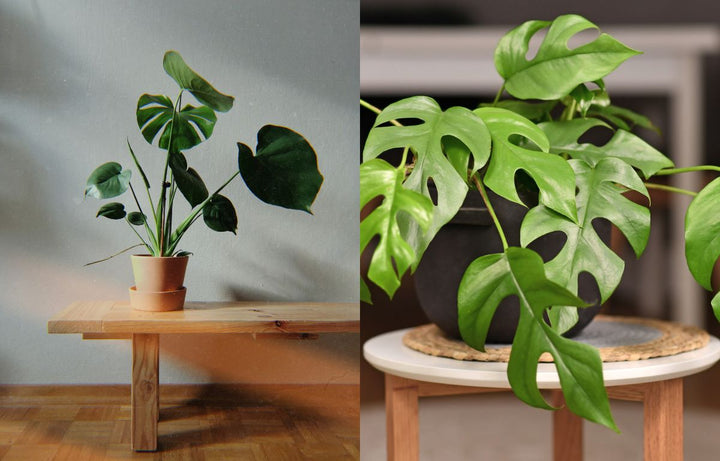
How To Distinguish Different Kinds of Houseplants
How To Distinguish Different Kinds of Houseplants
Houseplants are a delightful way to bring life and colour into our homes, but with so many varieties available, it's easy to confuse plants with similar appearances or names. Whether you're a seasoned plant parent or a green-thumbed newbie, understanding the differences between these commonly mixed-up houseplants can help ensure you're giving each plant the care it needs.

Pothos vs. Philodendron
Pothos (Epipremnum aureum)
- Leaves: Heart-shaped but more elongated, sometimes with variegation (yellow, white, or light green).
- Texture: Waxy and slightly thicker.
- Growth: Vigorous, trailing vines.
- Care: Thrives in low light and is quite drought-tolerant.
Philodendron (Philodendron hederaceum)
- Leaves: Heart-shaped, usually more rounded and softer than pothos leaves.
- Texture: Less waxy, thinner, and more delicate.
- Growth: Vines can be trailing or climbing with the help of aerial roots.
- Care: Prefers indirect light and regular watering.

Snake Plant vs. Spider Plant
Snake Plant (Sansevieria trifasciata)
- Leaves: Stiff, upright, and sword-like with variegated patterns of green and yellow.
- Texture: Thick and tough.
- Growth: Slow-growing; leaves grow vertically.
- Care: Extremely low maintenance; tolerates low light and infrequent watering.
Spider Plant (Chlorophytum comosum)
- Leaves: Long, slender, arching leaves, often with a central white stripe.
- Texture: Flexible and softer.
- Growth: Produces offshoots or "spiderettes" on long stems.
- Care: Prefers bright, indirect light and regular watering.

Monstera vs. Split-Leaf Philodendron
Monstera (Monstera deliciosa)
- Leaves: Large, glossy, heart-shaped with characteristic natural splits and holes.
- Texture: Thick and leathery.
- Growth: Can grow very large with proper support; climbs using aerial roots.
- Care: Prefers bright, indirect light and consistent watering.
Split-Leaf Philodendron (Thaumatophyllum bipinnatifidum)
- Leaves: Deeply lobed with a frilly appearance, often confused with the Monstera.
- Texture: Less leathery and more flexible than Monstera leaves.
- Growth: Spreads out rather than climbs.
- Care: Needs bright, indirect light and moist soil.

Peace Lily vs. Calla Lily
Peace Lily (Spathiphyllum spp.)
- Leaves: Broad, glossy, dark green leaves.
- Flowers: White, spoon-shaped spathes with a central spadix.
- Care: Prefers low to medium light and regular watering; sensitive to overwatering.
Calla Lily (Zantedeschia spp.)
- Leaves: Arrowhead-shaped, often with white spots.
- Flowers: Funnel-shaped spathes in various colors (white, yellow, pink, purple).
- Care: Needs bright light and well-draining soil; prefers consistent moisture.

Aloe Vera vs. Agave
Aloe Vera (Aloe barbadensis miller)
- Leaves: Thick, fleshy, and succulent with serrated edges; often spotted.
- Texture: Gel-filled, soft to touch.
- Growth: Forms rosettes; offsets or “pups” at the base.
- Care: Needs bright light and infrequent watering; drought-tolerant.
Agave (Agave spp.)
- Leaves: Thick, rigid, and pointed with sharp tips; sometimes with marginal spines.
- Texture: Hard and fibrous.
- Growth: Forms rosettes; slower growing than Aloe.
- Care: Requires bright light and well-draining soil; very drought-tolerant.

Traveller's Palm vs. Strelitzia
Traveller's Palm (Ravenala madagascariensis)
- Leaves: Large, paddle-shaped leaves that fan out symmetrically.
- Texture: Thick, with a waxy surface.
- Growth: Can grow quite tall; forms a distinctive fan shape.
- Care: Needs full sun and plenty of water, especially in warm climates.
Bird of Paradise (Strelitzia reginae)
- Leaves: Long, banana-like leaves.
- Texture: Leathery and stiff.
- Growth: Clump-forming; doesn’t grow as tall as Traveller's Palm.
- Care: Prefers bright, indirect light and regular watering.
Tips for Correct Identification
- Leaf Shape and Texture: Pay close attention to the shape, size, and feel of the leaves. Differences in leaf texture (waxy vs. soft) can be a key distinguishing factor.
- Growth Habit: Observe how the plant grows. Does it trail, climb, or stay compact? This can help differentiate between similar-looking plants.
- Flower Characteristics: For plants that bloom, the shape, color, and structure of the flowers can provide clear identification cues.
- Light and Watering Preferences: Understanding the specific care needs can also hint at which plant you have, as similar-looking plants might have different light and watering requirements.
By carefully examining these features, you can confidently distinguish between similar houseplants and ensure each one thrives in your care. Happy planting!
Interested to learn more? Read up on the Cowboy Cactus.
